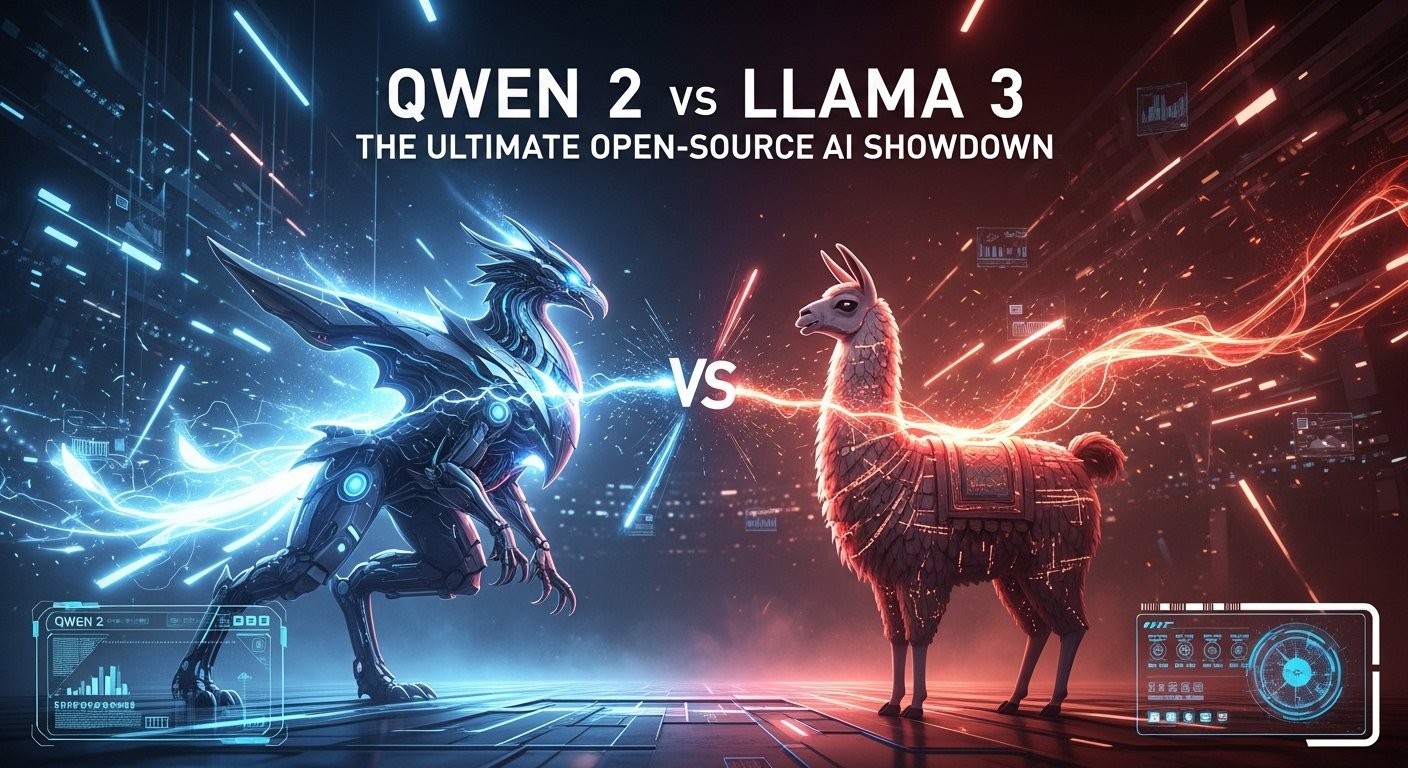The open-source AI landscape is heating up, with two major competitors stepping into the ring. The Qwen 2 vs Llama 3 debate isn’t just about crowning a new champion; it’s a critical decision for developers and businesses choosing the foundation for their next project. This battle defines the new open-source arena and will shape the future of accessible AI. This guide provides a definitive, head-to-head analysis to help you make the right choice.
Executive Summary: Power vs. Global Reach
In the direct comparison of Qwen 2 vs Llama 3, the best choice depends on your specific needs. Llama 3 excels in raw English-language performance and benefits from a massive, mature community ecosystem. Qwen 2 establishes itself as the new champion for multilingual applications and offers a highly efficient and balanced performance across a wide range of tasks.
This distinction arises from their development focus. Meta Llama 3 was built to push the boundaries of state-of-the-art performance, particularly in English. Meanwhile, the Qwen2 series was engineered with a global perspective, aiming to provide top-tier capabilities in many languages. This article will dissect these differences with practical tests, helping you choose the right foundation for your work.
The Contenders: Understanding the Open-Source Titans

To make an informed decision in the Qwen 2 vs Llama 3 matchup, you first have to understand their origins and design philosophies. One is the heir to a dynasty that defined the open-source community, while the other is a powerful global challenger built for multilingual dominance.
Meta’s Llama 3: The Evolution of a Community Superpower
Llama 3 is Meta AI’s latest generation of open-source models, building upon the massive success and community adoption of its predecessor, Llama 2. It’s designed to be a state-of-the-art, general-purpose model with a strong emphasis on raw performance, especially in English. Its development focused on curating an enormous, high-quality pre-training dataset, giving it exceptional capabilities in commonsense reasoning and instruction following.
The Llama 3 models incorporate an improved transformer architecture with optimizations like Group Query Attention (GQA) to enhance inference efficiency. It has solidified its place as a go-to foundation model for startups and researchers who need a powerful, adaptable, and community-supported Large Language Model (LLM).
Alibaba’s Qwen 2: The Polyglot Challenger for Global Reach
Qwen 2 is the powerful successor in Alibaba Cloud’s family of open-source models, specifically engineered to excel in multilingual tasks. While Llama 3 focused on perfecting English-centric performance, Qwen 2 was built from the ground up to be a true polyglot. It was trained on a massive and diverse dataset containing a significant portion of non-English languages and code.
This makes Qwen 2 an exceptionally strong performer in translation, cross-lingual summarization, and international business contexts. As a powerful clash of global AI titans, Qwen 2 represents a push towards more globally inclusive and accessible open-source AI.
At a Glance: Key Specification Showdown
Here’s how their core specifications compare.
| Feature | Llama 3 | Qwen 2 |
| Developer | Meta AI | Alibaba Cloud |
| Key Strength | Raw performance & community support | Multilingual excellence & efficiency |
| Available Sizes (Parameters) | 8B, 70B | 0.5B, 1.5B, 7B, 72B |
| Architecture | Optimized Transformer with GQA | Optimized Transformer with GQA & MoE in larger variants |
| Context Window | 8,192 tokens | Up to 128,000 tokens in certain models |
| Vocabulary Size | 128,000 tokens | 152,000 tokens (includes more multilingual characters) |
These architectural differences are a key focus in the competitive AI landscape, as seen in other open-source face-offs.
Showdown 1: The Multilingual Gauntlet (Qwen’s Home Turf)

This is the most anticipated showdown in the Qwen 2 vs Llama 3 comparison. Qwen 2’s core claim is its superiority as a polyglot model. We designed a gauntlet of tests to push these multilingual capabilities to their limits, moving beyond simple word-for-word translation to test true cross-lingual comprehension.
The Translation Test
We started with a difficult English paragraph full of idioms and asked for translations into Spanish and Mandarin Chinese.
Our Prompt: “The team knew it was crunch time. The project manager told them to bite the bullet and work through the weekend, even though it was a bitter pill to swallow. To succeed, they needed all hands on deck.”
Llama 3’s Response: Llama 3 provided a grammatically correct but overly literal translation. In Spanish, it translated “bite the bullet” to “morder la bala,” which is a direct but nonsensical translation of the idiom. It had to add an explanation in parentheses to clarify the meaning.
Qwen 2’s Response: Qwen 2’s translation was exceptional. It correctly captured the meaning, not just the words. In Spanish, it used the equivalent idiomatic expression “hacer de tripas corazón” (to make courage from one’s guts). In Mandarin, it perfectly conveyed the sense of urgency and collective effort without awkward literal translations.
Verdict: Qwen 2 is the decisive winner. It demonstrates a deep contextual understanding of cultural nuance and idiomatic expressions, making it a far more reliable tool for high-quality, natural-sounding translation.
The Cross-Lingual Reasoning Test
Next, we tested the ability to reason across different languages without translating first.
Our Prompt: We provided both models with a German-language news article about a city council’s new recycling initiative. Then, we asked in English: “What was the primary financial benefit mentioned for the city?”
Llama 3’s Response: Llama 3 was able to answer correctly. However, its process was transparent; it first identified and translated the relevant German sentence and then provided the answer based on its translation.
Qwen 2’s Response: Qwen 2 answered the question directly and concisely in English, without showing a separate translation step. It stated, “The primary financial benefit mentioned was the expected reduction in landfill fees by over €200,000 annually.” It felt like it understood the German text as fluently as it understood the English question.
Verdict: Qwen 2 wins again. While both found the correct answer, Qwen 2’s seamless ability to process information in one language and answer in another demonstrates a more deeply integrated multilingual architecture. This is a recurring theme in the showdown between different AI models.
The Verdict
For any task that requires high-quality multilingual performance, Qwen 2 holds a significant and undeniable advantage. From nuanced translation to cross-lingual reasoning, its performance proves that it was built from the ground up to be a true polyglot model, making it the superior choice for global applications.
Showdown 2: The Developer’s Playground

After establishing Qwen 2’s multilingual dominance, we now turn to the core territory for any serious open-source model: the developer’s playground. For this audience, performance on technical tasks like code generation and mathematical reasoning is a critical factor. We designed tests to see which model is the more reliable partner for logical and programming tasks.
The Code Generation Test
We started with a practical, real-world coding challenge that a data analyst or software engineer might face daily.
Our Prompt: “Write a Python script using the Pandas library that reads a CSV file named ’employee_data.csv’. The file contains ‘Department’ and ‘Salary’ columns. The script should calculate the average salary for each department and print the results in descending order.”
Both Qwen 2 and Llama 3 produced nearly identical, perfect scripts. They both correctly imported the Pandas library, used the groupby() and mean() functions efficiently, and sorted the results as requested. The code from both was clean, well-commented, and immediately runnable.
Verdict: This is a dead heat. For common code generation tasks, the Qwen 2 vs Llama 3 competition is incredibly close. Both models demonstrate state-of-the-art proficiency and are exceptionally reliable coding assistants for everyday programming needs.
The Mathematical Reasoning Test
Next, we tested their ability to perform multi-step logical deduction with a word problem modeled after the challenging GSM8K benchmark.
Our Prompt: “A bakery starts the day with 240 cupcakes. They sell 40% of them before noon. In the afternoon, they sell 2/3 of the remaining cupcakes. How many cupcakes are left at the end of the day?”
Once again, both models solved the problem flawlessly. They each broke down the problem into clear, sequential steps to arrive at the correct answer.
Shared Logic:
- Cupcakes sold before noon: 240 * 0.40 = 96
- Cupcakes remaining at noon: 240 – 96 = 144
- Cupcakes sold in the afternoon: 144 * (2/3) = 96
- Cupcakes left at the end of the day: 144 – 96 = 48
Verdict: It’s another tie. Both Llama 3 and Qwen 2 are top performers on mathematical reasoning benchmarks like GSM8K, and this test confirms their elite status. They can both reliably follow complex logic and perform accurate calculations, a level of performance that puts them in the same league as closed-source titans seen in the GPT-4o vs Gemini 1.5 Pro showdown.
The Verdict
When it comes to the core developer tasks of coding and mathematical reasoning, the race between Qwen 2 and Llama 3 is too close to call. Both models represent the pinnacle of open-source AI for technical proficiency. A developer choosing between them on these criteria alone would be well-served by either, as both are powerful and reliable tools for logical problem-solving.
The Fine-Tuning Factor: Which Model is Easier to Adapt?

For open-source models, out-of-the-box performance is only half the story. Their true power is unlocked through fine-tuning—the process of adapting the model to your specific data and use case. This section evaluates which Large Language Model serves as a better foundation to build upon.
Comparing Fine-Tuning Performance and Ease of Use
Both Llama 3 and Qwen 2 are designed to be highly adaptable using standard techniques like LoRA (Low-Rank Adaptation) and full fine-tuning.
- Llama 3: Due to its immense popularity, the ecosystem for fine-tuning Llama 3 is incredibly mature. There is a vast public library of tutorials, scripts, and pre-tuned models available, making it exceptionally easy for new developers to get started.
- Qwen 2: The Qwen 2 ecosystem is also robust and growing rapidly. The official documentation and support from the development team are excellent, and it responds very well to fine-tuning, especially for specialized multilingual tasks.
Verdict: We give a slight edge to Llama 3 for ease of use, simply due to the sheer volume of community-generated resources. However, both models are excellent candidates for custom fine-tuning.
The Ecosystem: Community Support, Tools, and Pre-trained Models
A model’s ecosystem can be just as important as its architecture.
- Llama 3: The community around Llama 3 is currently the largest and most active in the open-source world. This translates to more shared knowledge, more off-the-shelf fine-tuned models on platforms like Hugging Face, and faster solutions to common problems.
- Qwen 2: Qwen 2 has a very active and rapidly expanding global community, with particularly strong support in non-English speaking regions. Its official support channels are also highly responsive.
Verdict: Llama 3 currently has the larger and more mature ecosystem, which can accelerate development. However, Qwen 2’s rapid growth and strong official backing make it a formidable competitor. This clash of innovation extends beyond the models themselves and into the communities that support them.
Safety and Guardrails: Llama Guard vs. Qwen’s Alignment
Model safety is a critical concern for any real-world application.
- Llama 3: Meta provides powerful, separate guardrail models like Llama Guard. This gives developers a highly customizable tool to filter inputs and outputs, allowing them to define their own safety standards for their fine-tuned applications.
- Qwen 2: The Qwen 2 models have undergone extensive safety alignment during their pre-training. They are designed to be safe and helpful out of the box, with robust built-in protections against generating harmful content, especially across the many languages they support.
Verdict: This is a tie with different philosophies. Llama 3 offers more customizable safety, which is ideal for experts. Qwen 2 offers more built-in safety, which is simpler for teams that need a reliably safe baseline without extra configuration.
The Final Verdict: Which Open-Source LLM Should You Build On?

After a gauntlet of tests and a deep dive into their ecosystems, the verdict of the Qwen 2 vs Llama 3 showdown is clear. This is not a choice between a good and a bad model, but a strategic decision between two different types of excellence. Your choice will depend entirely on the nature and ambition of your project.
Choose Llama 3 if…
…you need maximum raw performance in English and want to leverage the largest, most mature community ecosystem.
If your primary focus is the English-speaking market and you want the fastest path to a high-performing model, Llama 3 is your best bet. Its performance in coding and reasoning is top-tier, and its massive community means more tutorials, more pre-tuned models, and more support.
- Personas: Startups, US/EU-focused developers, and researchers who can benefit from the vast existing ecosystem.
Choose Qwen 2 if…
…your primary need is state-of-the-art multilingual capability and a highly efficient, balanced model for global use cases.
If your application needs to communicate flawlessly with a global audience, Qwen 2 is the undisputed champion. Its victory in our Multilingual Gauntlet was decisive. Furthermore, its excellent efficiency and larger context window in some variants make it a very powerful and flexible choice.
- Personas: Global enterprises, developers targeting non-English markets, and creators of multilingual content and applications.
Frequently Asked Questions (FAQs)
Is Qwen 2 better than Llama 3 at coding?
No, in our tests for standard code generation tasks, they were tied. Both models are state-of-the-art and exceptionally proficient for everyday programming needs.
Which model has a larger context window?
Qwen 2 offers models with a significantly larger context window, up to 128,000 tokens in some cases, compared to Llama 3’s 8,192 tokens. This gives it an advantage for tasks involving long documents.
Are both Qwen 2 and Llama 3 truly open-source for commercial use?
Yes, both model families are released under permissive licenses that allow for commercial use, a key reason for their popularity among startups and enterprises.
Which model is more efficient to run on my own hardware?
Both model families offer a range of parameter counts and support quantization to run efficiently on consumer hardware. Qwen 2’s smaller models (e.g., 0.5B, 1.5B) are particularly notable for their high performance at a very small size.
Conclusion: The Open-Source World Has Two Champions
The ultimate showdown between Qwen 2 vs Llama 3 doesn’t end with a single winner. Instead, it leaves the open-source community with two powerful and specialized champions. The choice is no longer about finding the single “best” model, but about picking the right tool for your specific ambition. Llama 3 continues its reign as the king of the English-speaking ecosystem, while Qwen 2 has confidently taken the crown as the master of global, multilingual communication.
Just as with the closed-source titans, the real test is in your own hands. Take a core feature of your project, test it with both, and decide which champion will carry you into the future.
Which model are you building with? Share your choice and your reasons in the comments below!

